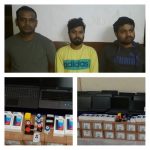Huge buildings floating on the water, beautiful parks around, huge cultural centers that provide entertainment at every step, hotels that serve delicious food, eye-catching fountains, greenery that spreads joy..
 –Galla S Kiran Kumar, Bureau Chief
–Galla S Kiran Kumar, Bureau Chiefwill be completed by 2030. The team of state representatives examined
the UN award for the water treatment process here .
A booming development along the banks of the Han River in Seoul, the capital of South Korea
Huge buildings floating on your T, beautiful parks around, huge cultural centers that provide entertainment at every step, hotels that serve delicious food, eye-catching fountains, greenery that spreads joy… Seoul, the capital of South Korea, is buzzing with many features. Seoul, which has a population of 1.20 crores in the main city, competes with other cities in the world in terms of tourism, trade and business. The Han river revitalization project is a key point in achieving this level. Although there are waterfronts in cities in various countries…it has been given high priority in recent times by multi-purpose development. The Telangana government team, which is visiting Seoul as part of Moosi revival scheme, on Tuesday inspected the works undertaken as part of Han riverfront development and discussed with the concerned officials. In this background, the steps taken for Han’s revival, the tasks undertaken and the achievements achieved.
Hong Kong is the largest river in South Korea. This is known as the Han River. This river, which originates in North Korea and flows in South Korea, is 540 km in total. travels It is 70 km in the Seoul metropolitan area and 1.3 km from the center of Seoul city. 52 km wide. flows along. With industrialization, migration to the city increased and the population grew. As the waste was dumped directly into the Han River, the water became polluted. The government has decided to protect the river from pollution and develop it further in the name of riverfront. In 2008, under the leadership of Oh-Sye-hoon, who served as mayor of Seoul from 2006-11, a massive project called the Han Renaissance was undertaken. Han convinced people that development would solve many of the problems facing the city. With the construction of embankments and highways along the river, huge apartments will come up on both sides.
Future Hangang (Han) Project General Affairs Director Park Kinyang said that two waterfront constructions, including Civet Island, were completed between 2008-10 with full government funding. It has been revealed that the majority of them have been completed while aiming to build a total of seven similar to Sewit Island. It has been revealed that a total of eight goals have been set in this order.
Civite Island built in the Han River
- Implementing city plans around the river
- Waterfront style urban development.
- Providing adequate space for citizens on both sides of the river.
- Making the river accessible to the people of the city.
- Linkage of historical buildings along the river.
- Construction of a riverfront theme park.
- Creating scenic views on both sides of the river.
- The aim is to connect the western part of the city to the sea by waterway. But after Mayor O-Shae-hoon stepped down in 2011… the project was shelved as too expensive and not feasible. Changes were made in this and re-titled in 2015 under the name ‘The Han River’s Nature Regeneration’. In 2021, after O-Shae-hoon was re-elected as mayor, the project was taken up in full swing. It is targeted to be completed by 2030. Public-private partnerships are encouraged to make riverfront development commercially viable.
74 km. Parallel highways along
There are 11 parks along the Han River. Paths for walking and cycling have been established. Both sides have given high priority to the development of roads. Currently 74 km. Parallel highways are under construction. Riverfront parks have been constructed in all nine districts. However, local environmentalists have expressed concern that artificial arrangements will affect the environment by creating barriers to the natural flow of the river. But the government continued to develop the riverfront, saying it would be key to Seoul’s economic development. Currently, with the development of islands in the river, the development of parks and roads on both sides of the river, Seoul has been shaped to compete with the world’s most important cities, a Perry manager said. He said that all the structures in the islands are fabricated structures and the pollution in the river has almost reduced.
Construction of 10 water treatment plants
Four sewage treatment plants have been constructed to prevent sewage from entering the river. Half of this treated water is released into the river. The remaining half of the water is used for public drinking and other purposes. Apart from this, six more drinking water treatment plants have been set up. It has received the best water treatment award from the United Nations. With a large number of convention centers, conference halls and huge restaurants, it has gained importance in terms of trade and tourism.







